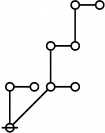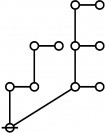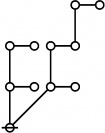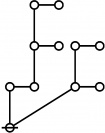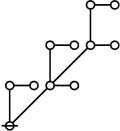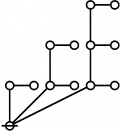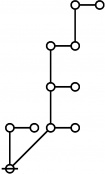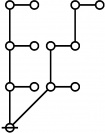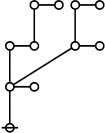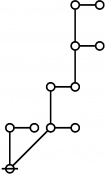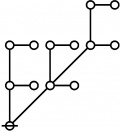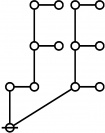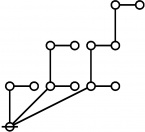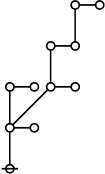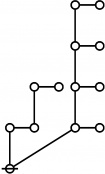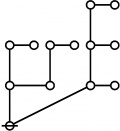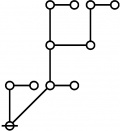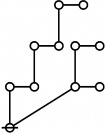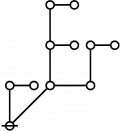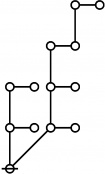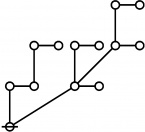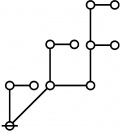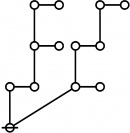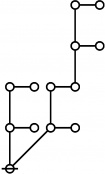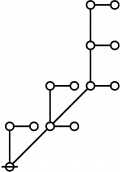Difference between revisions of "Directory:Jon Awbrey/Papers/Riffs and Rotes"
Jon Awbrey (talk | contribs) (→Idea: if you cache my drift ...) |
Jon Awbrey (talk | contribs) (→Idea: simpler example) |
||
| Line 40: | Line 40: | ||
| | | | ||
<math>\begin{matrix} | <math>\begin{matrix} | ||
| − | + | 123456789 | |
| − | & = & | + | & = & 3^2 \cdot 3607 \cdot 3803 |
| − | & = & | + | & = & \text{p}_2^2 \text{p}_{504}^1 \text{p}_{529}^1. |
\end{matrix}</math> | \end{matrix}</math> | ||
|} | |} | ||
| Line 48: | Line 48: | ||
Each index <math>i</math> and exponent <math>j</math> appearing in the prime factorization of a positive integer <math>n</math> is itself a positive integer, and thus has a prime factorization of its own. | Each index <math>i</math> and exponent <math>j</math> appearing in the prime factorization of a positive integer <math>n</math> is itself a positive integer, and thus has a prime factorization of its own. | ||
| − | Continuing with the same example, the index <math> | + | Continuing with the same example, the index <math>504</math> has the factorization <math>2^3 \cdot 3^2 \cdot 7 = \text{p}_1^3 \text{p}_2^2 \text{p}_4^1</math> and the index <math>529</math> has the factorization <math>{23}^2 = \text{p}_9^2.</math> Taking this information together with previously known factorizations allows the following replacements to be made in the above expression: |
{| align="center" cellpadding="6" width="90%" | {| align="center" cellpadding="6" width="90%" | ||
| Line 55: | Line 55: | ||
2 & \mapsto & \text{p}_1^1 | 2 & \mapsto & \text{p}_1^1 | ||
\\[6pt] | \\[6pt] | ||
| − | + | 504 & \mapsto & \text{p}_1^3 \text{p}_2^2 \text{p}_4^1 | |
\\[6pt] | \\[6pt] | ||
| − | + | 529 & \mapsto & \text{p}_9^2 | |
| − | |||
| − | |||
\end{array}</math> | \end{array}</math> | ||
|} | |} | ||
| Line 68: | Line 66: | ||
| | | | ||
<math>\begin{array}{lll} | <math>\begin{array}{lll} | ||
| − | + | 123456789 | |
| − | & = & | + | & = & \text{p}_2^2 \text{p}_{504}^1 \text{p}_{529}^1 |
\\[12pt] | \\[12pt] | ||
| − | & = & | + | & = & \text{p}_{\text{p}_1^1}^{\text{p}_1^1} \text{p}_{\text{p}_1^3 \text{p}_2^2 \text{p}_4^1}^1 \text{p}_{\text{p}_9^2}^1 |
\end{array}</math> | \end{array}</math> | ||
|} | |} | ||
| − | Continuing to replace every index and exponent with its factorization | + | Continuing to replace every index and exponent with its factorization produces the following development: |
{| align="center" cellpadding="6" width="90%" | {| align="center" cellpadding="6" width="90%" | ||
| | | | ||
<math>\begin{array}{lll} | <math>\begin{array}{lll} | ||
| − | + | 123456789 | |
| − | & = & | + | & = & \text{p}_2^2 \text{p}_{504}^1 \text{p}_{529}^1 |
| − | |||
| − | |||
\\[18pt] | \\[18pt] | ||
| − | & = & | + | & = & \text{p}_{\text{p}_1^1}^{\text{p}_1^1} \text{p}_{\text{p}_1^3 \text{p}_2^2 \text{p}_4^1}^1 \text{p}_{\text{p}_9^2}^1 |
\\[18pt] | \\[18pt] | ||
| − | & = & | + | & = & \text{p}_{\text{p}_1^1}^{\text{p}_1^1} \text{p}_{\text{p}_1^{\text{p}_2^1} \text{p}_{\text{p}_1^1}^{\text{p}_1^1} \text{p}_{\text{p}_1^2}^1}^1 \text{p}_{\text{p}_{\text{p}_2^2}^{\text{p}_1^1}}^1 |
\\[18pt] | \\[18pt] | ||
| − | & = & | + | & = & \text{p}_{\text{p}_1^1}^{\text{p}_1^1} \text{p}_{\text{p}_1^{\text{p}_{\text{p}_1^1}^1} \text{p}_{\text{p}_1^1}^{\text{p}_1^1} \text{p}_{\text{p}_1^{\text{p}_1^1}}^1}^1 \text{p}_{\text{p}_{\text{p}_{\text{p}_1^1}^{\text{p}_1^1}}^{\text{p}_1^1}}^1 |
\end{array}</math> | \end{array}</math> | ||
|} | |} | ||
| − | The <math>1</math>'s that appear as indices and exponents are formally redundant, conveying no information apart from the places they occupy in the resulting syntactic structure. Leaving them tacit produces the following expression: | + | The <math>1</math>'s that appear as indices and exponents are formally redundant, conveying no information apart from the places that they occupy in the resulting syntactic structure. Leaving them tacit produces the following expression: |
{| align="center" cellpadding="6" width="90%" | {| align="center" cellpadding="6" width="90%" | ||
| | | | ||
<math>\begin{array}{lll} | <math>\begin{array}{lll} | ||
| − | + | 123456789 | |
| − | & = & | + | & = & \text{p}_{\text{p}}^{\text{p}} \text{p}_{\text{p}^{\text{p}_{\text{p}}} \text{p}_{\text{p}}^{\text{p}} \text{p}_{\text{p}^{\text{p}}}} \text{p}_{\text{p}_{\text{p}_{\text{p}}^{\text{p}}}^{\text{p}}} |
\end{array}</math> | \end{array}</math> | ||
|} | |} | ||
Revision as of 12:54, 4 February 2010
Idea
Let \(\text{p}_i\) be the \(i^\text{th}\) prime, where the positive integer \(i\) is called the index of the prime \(\text{p}_i\) and the indices are taken in such a way that \(\text{p}_1 = 2.\) Thus the sequence of primes begins as follows:
|
\(\begin{matrix} \text{p}_1 = 2, & \text{p}_2 = 3, & \text{p}_3 = 5, & \text{p}_4 = 7, & \text{p}_5 = 11, & \text{p}_6 = 13, & \text{p}_7 = 17, & \text{p}_8 = 19, & \ldots \end{matrix}\) |
The prime factorization of a positive integer \(n\) can be written in the following form:
| \(n ~=~ \prod_{k = 1}^{\ell} \text{p}_{i(k)}^{j(k)},\) |
where \(\text{p}_{i(k)}^{j(k)}\) is the \(k^\text{th}\) prime power in the factorization and \(\ell\) is the number of distinct prime factors dividing \(n.\) The factorization of \(1\) is defined as \(1\) in accord with the convention that an empty product is equal to \(1.\)
Let \(I(n)\) be the set of indices of primes that divide \(n\) and let \(j(i, n)\) be the number of times that \(\text{p}_i\) divides \(n.\) Then the prime factorization of \(n\) can be written in the following alternative form:
| \(n ~=~ \prod_{i \in I(n)} \text{p}_{i}^{j(i, n)}.\) |
For example:
|
\(\begin{matrix} 123456789 & = & 3^2 \cdot 3607 \cdot 3803 & = & \text{p}_2^2 \text{p}_{504}^1 \text{p}_{529}^1. \end{matrix}\) |
Each index \(i\) and exponent \(j\) appearing in the prime factorization of a positive integer \(n\) is itself a positive integer, and thus has a prime factorization of its own.
Continuing with the same example, the index \(504\) has the factorization \(2^3 \cdot 3^2 \cdot 7 = \text{p}_1^3 \text{p}_2^2 \text{p}_4^1\) and the index \(529\) has the factorization \({23}^2 = \text{p}_9^2.\) Taking this information together with previously known factorizations allows the following replacements to be made in the above expression:
|
\(\begin{array}{rcl} 2 & \mapsto & \text{p}_1^1 \'"`UNIQ-MathJax1-QINU`"' '"`UNIQ-MathJax2-QINU`"' '"`UNIQ-MathJax3-QINU`"' '"`UNIQ-MathJax4-QINU`"' :{| border="1" cellpadding="20" | [[Image:Rote 802701 Big.jpg|330px]] |} '"`UNIQ-MathJax5-QINU`"' <br> {| align="center" border="1" cellpadding="6" |+ style="height:25px" | \(a(n) = \text{Rote Height of}~ n\) |
\(1\!\) \(a(1) ~=~ 0\) |
\(\text{p}\!\) \(a(2) ~=~ 1\) |
\(\text{p}_\text{p}\!\) \(a(3) ~=~ 2\) |
\(\text{p}^\text{p}\!\) \(a(4) ~=~ 2\) |
\(\text{p}_{\text{p}_\text{p}}\!\) \(a(5) ~=~ 3\) |
|
\(\text{p} \text{p}_\text{p}\!\) \(a(6) ~=~ 2\) |
\(\text{p}_{\text{p}^\text{p}}\!\) \(a(7) ~=~ 3\) |
\(\text{p}^{\text{p}_\text{p}}\!\) \(a(8) ~=~ 3\) |
\(\text{p}_\text{p}^\text{p}\!\) \(a(9) ~=~ 2\) |
\(\text{p} \text{p}_{\text{p}_\text{p}}\!\) \(a(10) ~=~ 3\) | |
|
\(\text{p}_{\text{p}_{\text{p}_\text{p}}}\!\) \(a(11) ~=~ 4\) |
\(\text{p}^\text{p} \text{p}_\text{p}\!\) \(a(12) ~=~ 2\) |
\(\text{p}_{\text{p} \text{p}_\text{p}}\!\) \(a(13) ~=~ 3\) |
\(\text{p} \text{p}_{\text{p}^\text{p}}\!\) \(a(14) ~=~ 3\) |
\(\text{p}_\text{p} \text{p}_{\text{p}_\text{p}}\!\) \(a(15) ~=~ 3\) | |
|
\(\text{p}^{\text{p}^\text{p}}\!\) \(a(16) ~=~ 3\) |
\(\text{p}_{\text{p}_{\text{p}^\text{p}}}\!\) \(a(17) ~=~ 4\) |
\(\text{p} \text{p}_\text{p}^\text{p}\!\) \(a(18) ~=~ 2\) |
\(\text{p}_{\text{p}^{\text{p}_\text{p}}}\!\) \(a(19) ~=~ 4\) |
\(\text{p}^\text{p} \text{p}_{\text{p}_\text{p}}\!\) \(a(20) ~=~ 3\) | |
|
\(\text{p}_\text{p} \text{p}_{\text{p}^\text{p}}\!\) \(a(21) ~=~ 3\) |
\(\text{p} \text{p}_{\text{p}_{\text{p}_\text{p}}}\!\) \(a(22) ~=~ 4\) |
\(\text{p}_{\text{p}_\text{p}^\text{p}}\!\) \(a(23) ~=~ 3\) |
\(\text{p}^{\text{p}_\text{p}} \text{p}_\text{p}\!\) \(a(24) ~=~ 3\) |
\(\text{p}_{\text{p}_\text{p}}^\text{p}\!\) \(a(25) ~=~ 3\) | |
|
\(\text{p} \text{p}_{\text{p} \text{p}_\text{p}}\!\) \(a(26) ~=~ 3\) |
\(\text{p}_\text{p}^{\text{p}_\text{p}}\!\) \(a(27) ~=~ 3\) |
\(\text{p}^\text{p} \text{p}_{\text{p}^\text{p}}\!\) \(a(28) ~=~ 3\) |
\(\text{p}_{\text{p} \text{p}_{\text{p}_\text{p}}}\!\) \(a(29) ~=~ 4\) |
\(\text{p} \text{p}_\text{p} \text{p}_{\text{p}_\text{p}}\!\) \(a(30) ~=~ 3\) | |
|
\(\text{p}_{\text{p}_{\text{p}_{\text{p}_\text{p}}}}\!\) \(a(31) ~=~ 5\) |
\(\text{p}^{\text{p}_{\text{p}_\text{p}}}\!\) \(a(32) ~=~ 4\) |
\(\text{p}_\text{p} \text{p}_{\text{p}_{\text{p}_\text{p}}}\!\) \(a(33) ~=~ 4\) |
\(\text{p} \text{p}_{\text{p}_{\text{p}^\text{p}}}\!\) \(a(34) ~=~ 4\) |
\(\text{p}_{\text{p}_\text{p}} \text{p}_{\text{p}^\text{p}}\!\) \(a(35) ~=~ 3\) | |
|
\(\text{p}^\text{p} \text{p}_\text{p}^\text{p}\!\) \(a(36) ~=~ 2\) |
\(\text{p}_{\text{p}^\text{p} \text{p}_\text{p}}\!\) \(a(37) ~=~ 3\) |
\(\text{p} \text{p}_{\text{p}^{\text{p}_\text{p}}}\!\) \(a(38) ~=~ 4\) |
\(\text{p}_\text{p} \text{p}_{\text{p} \text{p}_\text{p}}\!\) \(a(39) ~=~ 3\) |
\(\text{p}^{\text{p}_\text{p}} \text{p}_{\text{p}_\text{p}}\!\) \(a(40) ~=~ 3\) | |
|
\(\text{p}_{\text{p}_{\text{p} \text{p}_\text{p}}}\!\) \(a(41) ~=~ 4\) |
\(\text{p} \text{p}_\text{p} \text{p}_{\text{p}^\text{p}}\!\) \(a(42) ~=~ 3\) |
\(\text{p}_{\text{p} \text{p}_{\text{p}^\text{p}}}\!\) \(a(43) ~=~ 4\) |
\(\text{p}^\text{p} \text{p}_{\text{p}_{\text{p}_\text{p}}}\!\) \(a(44) ~=~ 4\) |
\(\text{p}_\text{p}^\text{p} \text{p}_{\text{p}_\text{p}}\!\) \(a(45) ~=~ 3\) | |
|
\(\text{p} \text{p}_{\text{p}_\text{p}^\text{p}}\!\) \(a(46) ~=~ 3\) |
\(\text{p}_{\text{p}_\text{p} \text{p}_{\text{p}_\text{p}}}\!\) \(a(47) ~=~ 4\) |
\(\text{p}^{\text{p}^\text{p}} \text{p}_\text{p}\!\) \(a(48) ~=~ 3\) |
\(\text{p}_{\text{p}^\text{p}}^\text{p}\!\) \(a(49) ~=~ 3\) |
\(\text{p} \text{p}_{\text{p}_\text{p}}^\text{p}\!\) \(a(50) ~=~ 3\) | |
|
\(\text{p}_\text{p} \text{p}_{\text{p}_{\text{p}^\text{p}}}\!\) \(a(51) ~=~ 4\) |
\(\text{p}^\text{p} \text{p}_{\text{p} \text{p}_\text{p}}\!\) \(a(52) ~=~ 3\) |
\(\text{p}_{\text{p}^{\text{p}^\text{p}}}\!\) \(a(53) ~=~ 4\) |
\(\text{p} \text{p}_\text{p}^{\text{p}_\text{p}}\!\) \(a(54) ~=~ 3\) |
\(\text{p}_{\text{p}_\text{p}} \text{p}_{\text{p}_{\text{p}_\text{p}}}\!\) \(a(55) ~=~ 4\) | |
|
\(\text{p}^{\text{p}_\text{p}} \text{p}_{\text{p}^\text{p}}\!\) \(a(56) ~=~ 3\) |
\(\text{p}_\text{p} \text{p}_{\text{p}^{\text{p}_\text{p}}}\!\) \(a(57) ~=~ 4\) |
\(\text{p} \text{p}_{\text{p} \text{p}_{\text{p}_\text{p}}}\!\) \(a(58) ~=~ 4\) |
\(\text{p}_{\text{p}_{\text{p}_{\text{p}^\text{p}}}}\!\) \(a(59) ~=~ 5\) |
\(\text{p}^\text{p} \text{p}_\text{p} \text{p}_{\text{p}_\text{p}}\!\) \(a(60) ~=~ 3\) |








